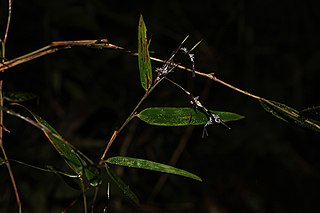Aulonemia bogotensis is a species of bamboo. It is part of the genus Aulonemia. The species is part of the grass family and is endemic to Latin America. The species is part of the grass family and is endemic to Latin America.
Aulonemia deflexa is a species of bamboo in the genus Aulonemia. The species is part of the grass family and is endemic to Latin America.
Aulonemia effusa is a species of bamboo in the genus Aulonemia. The species is part of the grass family and is endemic to Latin America.
Aulonemia fulgor is a species of bamboo in the genus Aulonemia. It is found mainly in North America. It is part of the grass family and endemic to Latin America.
Aulonemia jauaensis is a species of Aulonemia bamboo. It is part of the grass family and endemic to Latin America. It is part of the grass family and endemic to Latin America.
Aulonemia longipedicellata is a species of Aulonemia bamboo. It is part of the grass family and endemic to Latin America.
Aulonemia parviflora is a species of Aulonemia bamboo. It is part of the grass family and endemic to Latin America.
Aulonemia patriae is a species of genus Aulonemia of bamboo. It is part of the grass family and endemic to Latin America.
Aulonemia purpurata is a species of the bamboo genus Aulonemia.

Aulonemia pumila is a species of the bamboo genus Aulonemia. It is part of the grass family and endemic to Latin America.
Aulonemia patula is a species of the genus Aulonemia of bamboo. It is part of the grass family and endemic to Latin America.
Aulonemia yanachagensis is a species of bamboo of the genus Aulonemia. It is part of the grass family and endemic to Latin America.
Aulonemia viscosa is a species of bamboo of the genus Aulonemia. It is part of the grass family and endemic to Latin America.
Aulonemia setigera is a species of bamboo of the genus Aulonemia.
Aulonemia tremula is a species of bamboo of the genus Aulonemia.
Aulonemia trianae is a species of bamboo of the genus Aulonemia. It is part of the grass family and endemic to Latin America, with its native range in Columbia to Venezuela. It is most commonly found 8500 to 10500 feet above sea level.
Aulonemia ulei is a species of bamboo of the genus Aulonemia. It is part of the grass family and endemic to Latin America.
Aulonemia ximenae is a species of bamboo of the genus Aulonemia. It is part of the grass family and endemic to Latin America.
Aulonemia sodiroana is a species of bamboo of the genus Aulonemia.
Aulonemia insignis is a species of bamboo in the genus Aulonemia. It is part of the grass family and endemic to Latin America.

